Thankfully, most dog eyelid tumors are benign. But that doesn’t mean dog parents should ignore them. Integrative veterinarian Dr. Julie Buzby explains why it is important for you to schedule a veterinary appointment if you notice your dog has an eyelid tumor, and what the different tumor types could mean for your dog’s health.
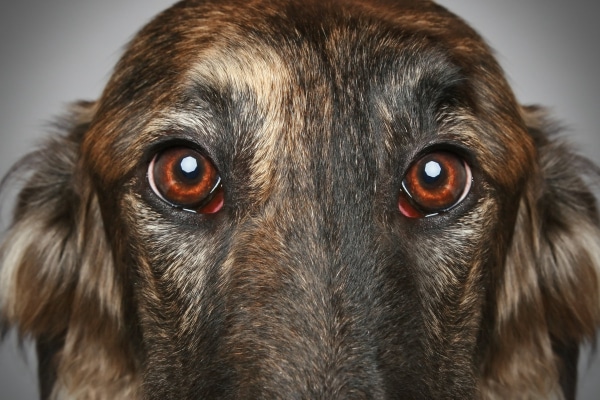
Recently, one of my clients brought her dog, Bambi, to see me. Her exuberant 8-year-old female Boxer had developed an odd-looking bump on her lower eyelid. Bambi’s mom reported that while it seemed like her dog could still see well, she was concerned about the spot on the eyelid and the fact that now Bambi had eye-boogers in that eye some mornings.
After giving Bambi some scratches and distracting her with a dog treat, I was able to get her to stop wiggling long enough to get a closer look at her eye. Sure enough, Bambi had a small pinkish mass protruding from the edge of her lower eyelid.
To help Bambi’s mom understand a bit more about eyelid tumors and my plan for treating Bambi’s tumor, I started with a quick sketch of the eyelids (shown below) and ran through the pertinent anatomy.

Eyelid anatomy 101
A dog has upper and lower eyelids, but only has eyelashes on the upper eyelid. Several muscles control the opening and closing of the eyelids to help cover and protect the globe (i.e. the eye itself). The inner surface of the eyelid is lined with pink conjunctiva, which reflects onto the globe.
Externally, haired skin makes up the part of the eyelid furthest away from the eye. But near the opening of the eyelid, there is a distinct line where the outer surface of the eyelid transitions to smooth, pigmented skin.
This area is the eyelid margin, which extends the whole distance around the eyelid opening. It should rest smoothly against the surface of the cornea (i.e. clear surface of the eye). And the eyelids should close completely to spread the tear film across the eye, wipe away dust, and protect the eye.
If you look closely at the border of the eyelid margin, you will notice a series of pinpoint dots. These are the openings of the Meibomian glands (i.e. tarsal glands), which are modified sebaceous glands that release oily secretions to contribute to the tear film.
As we dive into a discussion of eyelid tumors, it is important to keep this anatomy in mind. Tumors form when cells begin to abnormally divide and pile up on top of one another. Therefore, knowing the types of cells present in the eyelid can help you understand what types of tumors are possible.
What are the types of dog eyelid tumors?
Tumors of the eyelid may be benign (i.e. non-cancerous) or malignant (i.e. cancerous). Thankfully, about 75% of dog eyelid tumors are benign. And even those that are technically malignant may sometimes still act in a more benign fashion.
As I mentioned, tumors arise from cells in the area. This means that, broadly speaking, dogs may have masses of the meibomian glands, the haired eyelid skin, the conjunctiva, and the eyelid margins. More specifically, dogs can have the following types of eyelid tumors:
Meibomian gland adenoma/adenocarcinoma
The most common eyelid tumor of older dogs is a meibomian gland adenoma. These benign tumors occur due to an overgrowth of the cells lining the meibomian glands.
Initially, they may start out as a small, smooth mass that sticks out of the opening of a meibomian gland. However, over time they may grow into a large mass with an irregular surface. Some meibomian gland adenomas are pink, while others are pigmented. They can easily break open and bleed and/or distort the eyelid margin when they get big.
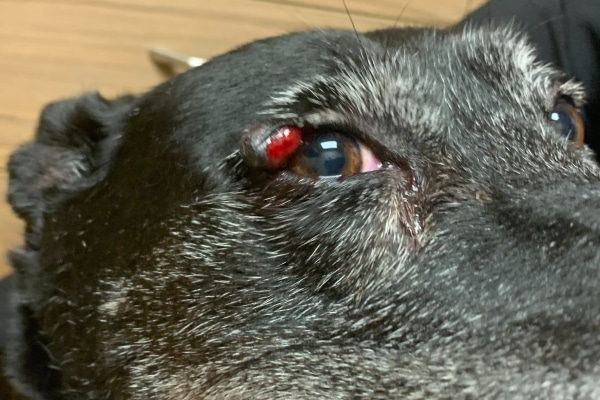
Occasionally, a dog will develop the malignant (i.e. cancerous) version of this tumor, which is called a meibomian gland adenocarcinoma. Thankfully, these tumors are rare and still tend to look and act very similar to benign tumors of the meibomian gland.
Melanoma
Another tumor that can impact the eyelid margin is a melanoma. These tumors arise from the melanocytes (i.e. pigment-producing cells) in the eyelid margin. In this location, melanomas are typically flat, brown-to-black masses that expand outward.
Alternatively, a dog can also develop a melanoma of the haired skin of the eyelid. These melanomas tend to be a single, round, darkly-pigmented mass on the eyelid itself, rather than the eyelid margin.
Mast cell tumor
Since haired skin composes part of the eyelid, a mast cell tumor in dogs (MCT) can occur on the eyelids. These malignant skin tumors arise from mast cells, which are immune system cells that typically play a role in allergic reactions.
Mast cell tumors may or may not have pigment and can look like just about anything. This makes them hard to recognize. Additionally, MCTs can grow rapidly and metastasize (i.e. send cells to other locations), which makes them more challenging to treat.
Squamous cell carcinoma
Rarely, dogs can also develop squamous cell carcinomas (SCCs) on their eyelids. These malignant tumors of skin cells often have an ulcerated appearance and are more common on areas of the eyelid that lack pigment. It is possible that UV radiation from the sun may play a role in causing eyelid SCCs in dogs.
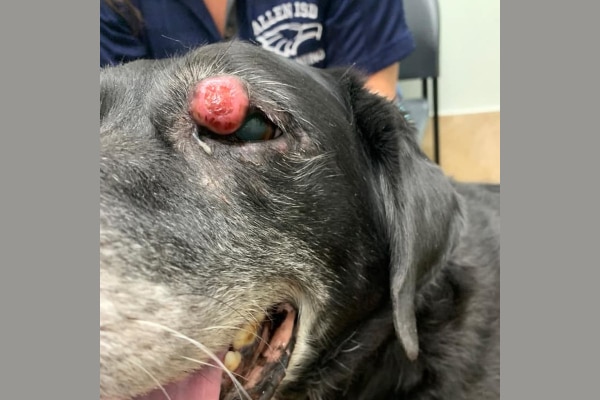
Papilloma
Young dogs tend to have viral papillomas (i.e. those caused by the papilloma virus). These wart-like growths may be white, pink, or pigmented and tend to have a cobblestone appearance. Dogs may have more than one papilloma at once, and they may occur around the eyes and in the mouth at the same time. Sometimes, but not always, papillomas will go away on their own.
Histiocytoma
The other eyelid tumor that tends to impact young dogs is a histiocytoma in dogs. These benign tumors of Langerhans cells (i.e. immune system cells in the skin) often look like red, hairless, round buttons, and can pop up quickly. Dogs may develop a histiocytoma anywhere on their body. But they are more common on the face, head, and front end.
What are some eyelid bumps that aren’t tumors?
On the other hand, the eyelid can also have a cyst (i.e. localized collections of fluid or cellular debris) or areas of inflammation or infection. These eyelid masses may look like tumors but are in fact not caused by abnormal cell division.
Meibomian gland cysts in dogs
Sometimes a meibomian gland tumor may block the opening of the meibomian gland. This traps oil and debris within the gland. As the material builds up, it can create a distinct area of swelling in the eyelid and conjunctiva. You may have heard this swelling referred to as a meibomian gland cyst or a chalazion.
Since meibomian glands are modified sebaceous glands, a meibomian gland cyst is essentially a sebaceous cyst in dogs, but on the eyelid margin.
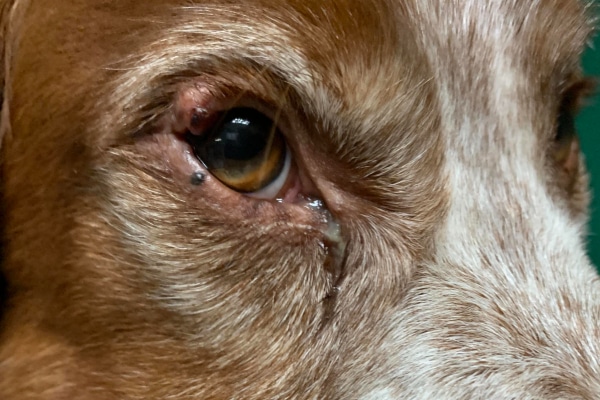
Inflammation
Sometimes meibomian gland cysts will rupture into the surrounding tissue and cause an inflammatory reaction. This may make it look like the mass has grown rapidly.
Infection
Additionally, dogs may develop an abscess near or on their eyelids, which can lead to a “bump” on the eyelid. This occurs when an injury introduces bacteria deep into the skin. As the bacteria multiply, they create a walled-off pocket of pus, which is an abscess.
Alternatively, dental disease in dogs can lead to a tooth abscess in dogs. Since the upper tooth roots lie in the sinuses, which are right below the eye, a tooth root abscess can cause eyelid and face swelling. And eventually it may rupture through the skin close to the lower eyelid.
What are the symptoms of a dog eyelid tumor?
Sometimes the first sign you will notice is the actual tumor (or other bump) as we just discussed. But other times, a dog may be showing eye-related symptoms which cause you to look closer at the eyelid and discover the mass. Some of these signs include:
- Squinting or holding the eye closed (i.e. blepharospasm)
- Tearing
- Cloudy eyes in dogs
- Rubbing the face
- Bleeding from the mass
- Being unable to fully close the eyelids
These signs may be related to irritation from the mass. Or the mass may be an incidental finding and your dog actually has a different eye problem. Either way, it is good to consult with your vet if your dog is showing any of the signs on this list.

To help you decide if you should go for an emergency vet visit or make a general appointment, ask yourself these questions:
- Is my dog squinting?—Squinting is the body’s way of showing the eye is painful. Head to the vet promptly to get your dog some answers and pain relief.
- Is my dog’s eye cloudy?—Eyes that are suddenly cloudy and painful may go along with serious conditions like acute glaucoma in dogs, uveitis in dogs, or a corneal ulcer in dogs. It is best to get to the vet ASAP.
- Is the mass bleeding?—If the eye is otherwise clear and comfortable, and the bleeding from the mass stops when you apply pressure, it probably isn’t an emergency. Consider placing an E-collar on your dog to keep him or her from rubbing at the mass. Then make a regular appointment with your vet.
What can I expect at the vet appointment?
When you bring your dog to the vet (either as an emergency or as a standard appointment), your vet may:
- Ask you questions about your dog’s history—when you noticed the symptoms and/or mass, how the symptoms or mast may have changed, etc.
- Examine your dog from nose to tail.
- Carefully examine the eyelid as well as the eye itself. This may involve using fluorescein stain to look for corneal ulceration secondary to the mass rubbing the cornea, measuring tear production in the eye, evaluating the eye pressures, and/or measuring the diameter of the mass.
- Perform any necessary blood work to assess your dog’s overall health in preparation for surgery.
- Use ultrasound, X-rays, or other tests to determine if a potentially malignant tumor has spread to other areas of the body.
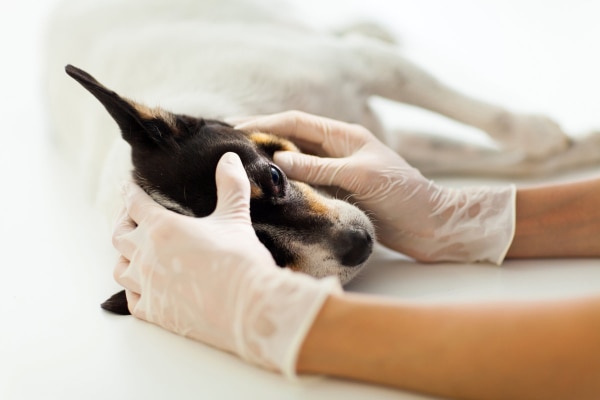
What is the treatment for eyelid tumors in dogs?
Once your vet has fully evaluated your dog’s eye and eyelid mass, he or she will work with you to devise a treatment plan. This often has two parts—addressing the mass itself, and addressing any effects of the mass.
As discussed in the anatomy section, the eyelids need to lie flat against the eye and close completely. Otherwise they can’t do their job properly. Therefore, even benign masses on the eyelid (which most of them are) can distort the eyelid and cause significant issues. Also, there are limitations on how much eyelid the vet can remove without compromising function, so addressing a mass while it is small is ideal.
For these reasons, veterinarians typically recommend removing any eyelid mass that is larger than two to three millimeters. This approach maximizes the chances of the vet being able to completely remove the mass without disrupting eyelid function. There really aren’t any homeopathic remedies for dog eyelid tumors or at-home treatments that are effective, so tumor removal surgery is generally the best option.
Surgical removal of eyelid tumors
Depending on the size and location of the tumor, the vet may use one of several procedures:
- Laser ablation—Sometimes the vet can use a surgical CO2 laser to carefully “burn off” small masses.
- Wedge resection—If the tumor on the dog’s eyelid takes up less than 30% of the length of the eyelid, the vet can remove the tumor using a wedge resection. As the name implies, this procedure involves removing a small wedge of the eyelid along with the tumor itself. Then the vet will use a special suture pattern to line up the eyelid margin again and close the defect.
- Blepharoplasty—Larger or more invasive tumors are challenging to treat because removing too much of the eyelid can lead to a small eyelid opening and poor eyelid function. Thus, a veterinary ophthalmologist may need to use special techniques to remove a large tumor and reconstruct the eyelid.
- Cryotherapy—Certain tumors may respond well to using a local anesthetic and cryotherapy (i.e. freezing them off). Others may be more suited to debulking and then cryotherapy.
- Enucleation—In rare cases where the tumor is particularly large, aggressive, or invasive, the vet may recommend an enucleation (i.e. removing the whole eye).
After the vet removes the mass, he or she may recommend submitting it for histopathology (i.e. biopsy). This will allow the vet to determine the type of mass and plan for any necessary follow-up. Dogs with malignant masses may sometimes require additional diagnostic tests to determine if the tumor has spread to the lymph nodes, chest, or other areas.
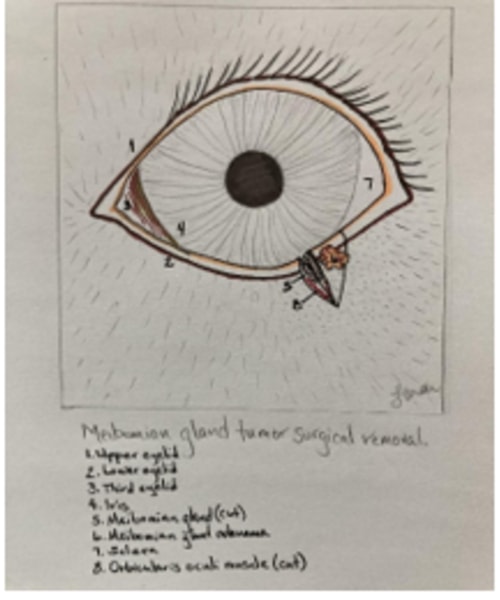
Adjunctive therapy
Prior to and after surgery, the vet will also address any issues the tumor may have caused. Sometimes this involves treating a corneal ulcer or using lubricating agents to keep the cornea moist. Other times the dog may need chemotherapy or radiation for malignant tumors or other adjunctive therapies.
What does eyelid tumor surgery recovery involve?
After eyelid surgery to remove the mass, your vet will send your dog home with specific post-op instructions. Some of them may include:
- Applying antibiotic or lubricating ointment to the affected eye several times a day.
- Administering anti-inflammatory or pain medications.
- Using an E-collar to keep your dog from scratching or rubbing at the surgical site.
- Preventing your dog from roughhousing with other pets.
- Cleaning the surgical site with a warm washcloth to remove any debris.
It is very important that you follow you vet’s instructions. If your dog rips the sutures out or irritates the area, this may delay healing or cause permanent eyelid disfiguration.
What is the outlook for dog eyelid tumors?
In general, if you catch the eyelid tumor early and carefully follow the post-op instructions, the overall prognosis is good. More specifically, the prognosis for each tumor type is as follows:
- Meibomian gland adenoma—Complete surgical removal is curative. With debulking and cryotherapy, about 15% of dogs will experience a reoccurrence.
- Meibomian gland adenocarcinoma—Complete surgical removal is often, but not always, curative.
- Melanoma— Prognosis is good if completely removed. Some vets feel that the melanoma vaccine for dogs may also be beneficial but there isn’t data to support that use of the vaccine yet.
- Mast cell tumor—It is difficult to fully remove eyelid mast cell tumors because they require large surgical margins. This means the dog may need blepharoplasty to create a functional eyelid and/or chemotherapy or radiation to address remaining tumor cells.
- Squamous cell carcinoma—Some SCCs respond well to removal but others may require cryotherapy, hyperthermia, or other therapies.
- Viral papilloma—Most regress spontaneously on their own. Crushing one with forceps seems to promote resolution.
- Histiocytoma—Most go away on their own in younger dogs. Occasionally, an older dog may need surgery, steroids, or cryotherapy to address the histiocytoma.
My patient’s happy ending

Now, back to my patient. This generally good prognosis for eyelid tumors played out in Bambi’s case too. Due to the size and location of her mass, I decided that a wedge resection would be the right choice for Bambi’s eyelid tumor surgery. My patient came through surgery with flying colors and was soon reunited with her mom.
I sent her home with an E-collar to protect the incision, as well as anti-inflammatories to reduce pain and swelling. The pathology report revealed that Bambi had a meibomian gland adenoma, which meant it was benign and unlikely to regrow or cause further issues. She was left with a slight defect in her hair but has a nice smooth eyelid margin that will keep her eye protected for many more romps in the park.
Eyelid tumors are not a wait and see scenario—Speak with your vet
One of the biggest takeaways I hope you get out of this article is this: It’s important to act when an eyelid mass is still small. The eyelid is such a delicate area and relies greatly on its normal shape to function properly. Thus, if you notice eyelid masses or any concerning eye symptoms, please make an appointment with your vet.
It is much better to go to the vet when the mass is small and easy to remove than it is to keep watching the mass until it gets big, starts bleeding, or interferes with eyelid function. Your vet can assess the mass and make a plan to remove it. Then, since most masses are benign and resolve completely with surgery, chances are good you can put it all behind you and keep living life to the fullest with your dog.
What type of eyelid tumor did your dog have?
Please comment below.


Hi my dog is scheduled for surgery in 5 days to remove the mass on his top eyelid. It partly ruptured yesterday so I cleaned it with saline wipes & put a soft cone around his neck. Unfortunately overnight, he has scratched it & woken up with blood around his eye with a very swollen top eyelid. My vet is closed because it’s Sunday! Other than Saline wipes & wearing the cone, can you suggest any other treatment till his surgery in 5 days? As I said it is swollen but there’s no other sign of discharge. I’m concerned that it has become infected. Anxiously awaiting your reply
Hi Kelly,
I understand your concern for your pup and I’m sorry I wasn’t able to reply before now. There isn’t much you would have been able to do from home or with over-the-counter product. The best thing would have been to contact your vet first thing Monday and see if they wanted to start an anti-inflammatory medication or antibiotics. How did things go? Was your pup able to proceed with surgery as planned? Feel free to leave an update if you have a chance. Hoping all is well and wishing you both the best!
hi! around 3 weeks ago my girl aged 13 developed a bump under her left eyelid after noticing her continuously rubbing it and tear stains from her eye (she never had any tear stains before). today the lump has grown to what i think to be 10 times the size (2cm along her eyelid) of when i first noticed it. at first i thought if i stopped her from rubbing her eye it’ll go away. i eventually took her to the vet as it was growing way too fast in such little time. vet gave us chloramphenicol eye ointment to apply twice a day and it’s been the second day now i feel like its gotten worse over the 2 days. also the vet didn’t have a clue what it is and was just giving me options to “try”. i’m now starting to see the mass visible from the bottom of her eyelid. it looks like a lot of lumps formed together. it’s fleshy and a bit of white in colour. would you have a clue what it could be and do you recommend just getting it surgically removed as soon as possible? i regret not doing more research online before i consulted the vet. i might’ve chosen to get it removed instead of risking it getting worse. also it is something i should be concerned about it coming back after removing? below are the links to photos of her eye.. thanks in advance
https://drive.google.com/file/d/1hmwu8ePs_k1lKUF9dXNof41_nxBi4ryv/view?usp=drivesdk
https://drive.google.com/file/d/1IY-FrMxqIKzIXxawQdTxtAFw127-48NY/view?usp=drivesdk
Hi Mikky,
I understand your concern for your senior girl with this unknown eye issue she is dealing with. Unfortunately, without examining her myself, it is hard to make specific conclusions and recommendations. I can’t really tell that anything is wrong in the pictures you attached. I wish I could offer better advice. It might be best to ask for a consultation with a veterinary ophthalmologist. They have lots of experience dealing with complicated and rare cases and would be a good source of information. Hoping you can find the answers you need to ensure your girl remains happy and healthy. Best wishes to you both!
Hi there,
I am reaching out as our 10 year old English Bulldog/pit mix is experiencing a tumor that has grown rapidly over a few months.
We took him to the vets when we first detected it but the vet was worried about him going under anesthesia due to him being short nosed and his age and lungs …
They wanted to do a full test and then surgery however, the initial cost was going to be over $2k and we were unable to go forward …
His tumor has grown extensively and has been bleeding and is now drooping and covering his whole right eye ….
It breaks my heart every day knowing right now surgery is not an option.
Based on its rapid growth we are of course concerned that this is malignant … and wanted to know of other options we can do for him regarding if him suffering with any pain … and discomfort ..
We have ALWAYS … been there for our animals and unfortunately due to our financial situation we would have been able to deal with this in a much quicker and more humane way …
If you have any thoughts or suggestions we would value them.
Many thanks
Rebecca
Dear Rebecca,
I am sorry your senior guy is living with this large mass over his eye. I understand your concern and know how hard it is to have your options limited by finances. Unfortunately, I am not aware of any over the counter products or alternative therapies that would be able to improve this situation. It sounds like you may be facing some difficult choices about your boy’s quality of life. Sometimes saying goodbye is the most loving option and only way to offer relief and freedom from pain. Of course, without examining him myself, I can’t make specific conclusions. Don’t hesitate to ask your vet if they think your pup is suffering. They can give you their honest opinion and offer guidance as you navigate this emotional path. Praying for comfort and clarity and wishing you all the best. Bless you and your sweet boy.
My Dalmatian, Poppy, has a hairless pink mass (2-3 mm) on her upper eyelid. She had two similar ones on her other eyelid about 4 months ago. FNA said it was inflammatory response vs plasmacytoma. But the masses went away on their own while awaiting the report (I had her on Benadryl after the biopsy).
Now this one has popped up — right as we complete treatment for a corneal ulcer — and is really itching her and bothering her. I’m really concerned this could be a MCT. Am I overreacting?
Hi Beth,
I am sorry Poppy is experiencing discomfort from this mass on her eyelid. I don’t think you are overreacting at all and am also suspicious this could be a mast cell tumor. I strongly encourage you to have your vet examine Poppy and try to get an FNA of this new mass. Hoping for quick answers and a clear path forward with treatment. Feel free to keep us updated on how things are going. Best wishes to you and your sweet girl.
My senior dog has a Meibomian gland adenoma on his eyelid that is too big to surgically remove. Is there any thing naturally that will shrink this? It doesn’t seem to bother him.
Hi Mandy,
I am sorry your senior guy is dealing with this worrisome tumor on his eyelid. I am not aware of any natural treatment for this condition. It may be a good idea to reach out to a holistic or integrative vet in your area for advice. Also, you can see if there is a specialist in the area that might have the ability to do cryotherapy to remove the mass. Hoping you can make the best choice for you and your sweet boy. Take care!
My 12 yr old dog has a small mass on her bottom eyelid that kind of resembles a wart. Its been there for at least 6 months but I noticed today it has grown a little. i had her to the vet in May for a checkup but he missed it. I didn’t remember to ask him to look at it either. Now I feel bad I didn’t. Anyone got any suggestions, i. e. natural remedies.
Hi Barbara,
I am sorry your senior girl has developed this mass on her lower eyelid. I am not aware of any over the counter therapies that would be helpful in this situation. Also, I wanted to offer a word of caution about applying topical remedies as they will be at risk of getting into the eye. Eyes are very sensitive and can react badly when certain substances make direct contact. Your best course of action is to contact your vet and see if they will take a look at the mass. Hoping for clear answers and an easy solution. Best wishes to you and your sweet girl.
Our dog Hazel has a hyperkeratotic, very frondy mass on her eyelid margin that came on pretty quickly. It has a small base and a tear drop shaped, movable, not sensitive “body.” Probably about 2cm, eye itself is totally fine, but has recently gotten heavy enough that it’s dragging her eyelid down a tiny bit. We put her on azithromycin and have her scheduled for a laser ablation, but she just rolled really hard in some dirt while we were out swimming and pulled about 3/4 of the mass off. Horrifying. It did give us the opportunity to see what’s going on inside the mass, though, which was keratinized fronds through and through with no vasculature. All of the bleeding came from where it tore away at the base, which is a pretty small raised lump that’s pinkish in color. We’re planning to go ahead with the ablation and keep giving her the abx, but we still don’t totally know what it is! Maybe a papilloma?
Hi Caiti,
Poor Hazel! I am so sorry she is dealing with this bothersome mass on her eyelid. A papilloma is possible but with its location I would be suspicious it is related to the meibomian glands in that area. Hopefully your vet is planning to send the tissue off for pathological evaluation. That way you can get some definite answers and understand if this will have the possibility of recurring. Wishing your girl a smooth and successful surgery. Feel free to update us as you gather more information!
Hello! I have a 5 year old King Charles Cavalier Spaniel and noticed 5 months ago that a small blackish brown dot started developing on the middle of his lower eyelid. We were not too concerned, but now it has gotten bigger and is the size of an ant. It hasn’t bothered him at all and we thought just to be safe we’d take him into the vet today. The vet did not know what it was but did raise the concern of a possible melanoma. Ever since our Cooper was a baby he has had some form of eye issues- he also has allergies that gives him chronic ear infections, itchy bum, and swollen/red eyes. The vet has said before they believe he may have an autoimmune disease. Our vet also believed it could possibly be a pigmentation change due to previous eye issues. She couldn’t really say what it was but gave us the option of testing him for melanoma. I have been looking up pictures and it does not seem to match what he looks like he has. It is not raised and does not seem to bother him. Any advice or insight would be highly appreciated!
Hi Samara,
I understand why you are reaching out for advice about this worrisome bump on your dog’s eyelid. Without removing the spot and submitting tissue for a pathological evaluation, I am not sure there is really a way to know if this is cause for concern or not. As the article states, surgical removal can only be performed while the spot is still very small. So regardless of the cause, it may be best to discuss surgery with your vet. If you need more information or want an expert opinion, you can ask your vet for a referral to a specialist. A veterinary ophthalmologist could give you a better idea of what this spot could be and go over all the treatment options and their prognosis. Hoping you can find the answers you need to ensure your sweet boy remains happy and healthy for as long as possible.
Hi Dr. Buzby,
Our 9 year old husky/German shepherd just had surgery to remove a mass on his lower eyelid. We had it biopsied and it came back as Squamous Cell Carcinoma and they unfortunately didn’t get it all. Have you seen this type of scenario before? Do you have any recommendations for natural remedies or supplements that may help?
Thank you for your time.
Hi Desiree,
I am so sorry you are in this difficult situation. While we always strive to get clean margins when removing any type of tumor or growth, it is always a possibility that some could be left behind. I am not sure I know of natural remedies for SCC but there are definitely options for treatment. I highly recommend you talk to your vet about the possibility of a referral to a veterinary oncologist. They will have information on all the latest treatment options and what the typical prognosis is for each. I am hopeful you will get some answers and find the best way forward. Praying for many happy days to come.
I got from the shelter a 7 year old epileptic dog she developed a small mass on one eye, it looked like a pimple initially but now it’s lighter. here in southern Italy they don’t know how to help me, I put antibiotic ointment but it doesn’t go away. Could I send you a photo via email to ask for advice? Thank you in advance
Dear Miriam,
I understand your concern for your senior pup. Without personally examining her I am not sure I would be able to give specific advice. While telemedicine may be your best option, I feel it would be better spent with a veterinary ophthalmologist or other specialist. There may be a veterinarian in another country that could do a video consultation. I recommend you talk to your vet about this possibility. In my experience, if the mass is not causing injury to the eye and it is not bothering the dog, then it may be ok to leave it for now. If the eye is becoming injured due to the size or location of the mass, then surgical removal could be the best solution. I hope you can find the answers you need to choose the best path. Wishing you and your sweet girl nothing but the best.
I have seen a street dog with such a big thing like structure around his eyes a few days ago . but when I saw him today it was bursted and had affected his one side face.
will he be able to survive?
Hi Aruna,
I feel so bad for that poor pup. Without examining the dog, myself, there is really no way to know how this will affect his health. As long as the structure was not cancerous, and if it can heal without getting infected, the dog may have a chance to go on and live a normal life. Hopefully someone will be able to catch him and get him the medical attention he needs.